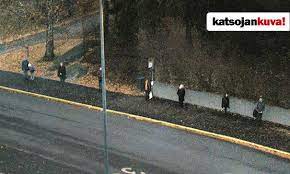I am originally from Germany and moved to Finland almost four years ago. For two and half years l lived with a Finnish host family. This time, as well as my Finnish friends whom I met while studying majorly, account for my experiences of Finnishness.
I had never really been aware of my own culture. It was only when I moved to Finland that I noticed differences in peoples’ behaviours and thought patterns. In the following I will go through few elements of Finnishness that were particularly remarkable to me when I first came:
Finns find joy in calmness, appreciate their personal space, take time for themself, are pretty straightforward about most things while being humble or modest people. This shows in many everyday situations. Let’s take travelling by bus as an example – the picture below tell more than words (and as communicating with as few words as possible is part of Finnishness, I will adapt 😉)
Finnishness in free-time activities is basically divided into three different yet somehow connected major themes:
- Drinking: longdrinks or the famous karhu beer in combination with a visit to a karaoke bar or drinking lots of black coffee eventually in combination with ice cream or a munkki)
- Nature: Finns are very sportive and active people and also I have learned to enjoy spending my free time taking a walk in the forest or spending the weekend at the cottage (as far away from others as possible😉)
- Sauna: warning: the above-mentioned need for personal space and privacy does not apply here! Sitting naked and sweating in a tiny hot room packed with people is an important part of Finnishness. Going afterwards for the mandatory swim in a close-by lake (regardless of the outside temperature) defiantly requires (at least for me) Finnish perseverance or so-called sisu.
When moving abroad and starting to recognize differences in culture, behaviour, attitudes, etc. it is easy to stick to one’s own culture yet it is especially then important to remember to stay open to and observe the culture while then picking the best parts of the culture and adapting pits and pieces to make it your own.







Comments